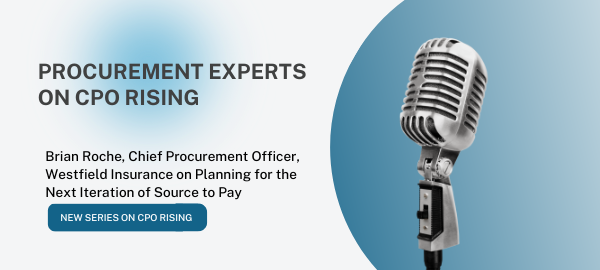Our “Procurement Experts on CPO Rising” series continues today with an excerpt from my 2021 episode of the Procurement Rising Podcast — Brian Roche, a Procurement Expert and the Chief Procurement Officer at Westfield Insurance (click to listen to the full interview). Note that this excerpt has been edited for readability.

Andrew Bartolini: Let’s talk for a moment about utilizing sourcing technology. How do you respond in circumstances when you see an opportunity, but the team may disagree on the sourcing technology approach? Do you have those types of conversations?
Brian Roche: This is a great question. We all hold each other equally accountable for carrying out the objectives that we’ve set for the year. So, each of the category managers on our team can make that call. And because we’re results based, we want to see if the decision to use certain aspects of our technology and other technologies is getting us to the optimal solution. Thus, we’ll look at results such as, were we able to negotiate savings or reduce charges that we would otherwise pay if not involved in cost avoidance initiatives? If those core things are executed and delivered, and the business is happy with the process, then that makes it a lot easier not needing to spend much time debating the approach that we took and the technology that we used. The team is accountable for figuring that out and we track the results based on what our expected outcomes would be.
AB: I think it’s important that if you’re not using this sourcing technology, that you are using some other type of collaborative tool to ensure the that work sourcing the category this year is captured and leveraged in future opportunities. Let’s talk about what comes after source to pay.
BR: That’s a couple of things, I guess. The next iteration of source to pay is both a concept and a technology consideration. I’ve seen other organizations take an approach to invest in a suite, while others take a purpose builder, best-in-class approach and integrate those modules. In the end, for me, it all needs to be complementary and supportive of the business goal and not the procurement goal. We talk about the things that we all feel as procurement professionals are important. We have a responsibility to help the business manage its investment with vendors most effectively, tracking that through savings and cost avoidance. But I think we’ve got to be careful not to lead with that and ensure that the business understands the value. And if there are things we need to do differently, we pivot and adjust accordingly.
I think every culture is different. The approach and the technology that we use today (which will evolve over time) need to be complementary to that culture and, quite frankly, the industry as well. And there’s a difference whether you are in direct versus indirect sourcing. Where are the demands? What is the impact of supply chain disruptions? Those are going to vary. And that’s going to help us drive where we focus and what technology and business processes are going to make the most sense for us. We’ll make that call based on which technology and processes best position us to be the most effective, but also to continue to be more efficient. This leads to my second point around automation considerations and AI.
We’re staying really connected to that agenda in the procurement space through conversations with peers and industry affiliation. But I also think what’s really relevant is the company’s digital journey and prioritization. We’re spending a lot of time and investment on growing our commercial lines of business. There’s a lot of change in the early steps within that process in terms of acquiring business and how we can use digital platforms to support that, complementary to the way that we do it today.
Thus, the focus on procurement and those processes will be something that we’ll continue to promote, but it has to fit within the context of the organization’s digital journey. We’ll continue to stay connected to them and promote where we can. I want to be realistic about the ideas that we have and the level of excitement we have around being more automated and more efficient with what the company is willing to support in the near term, the medium term, and the long term. We’ll continue to stay connected to that and fit in where we can.
MORE CPO TOPICS
Procurement Experts on CPO Rising — Changing Mindsets for Digital Transformation
Procurement Experts on CPO Rising – Achieving Big Returns on Spend Under Management
Procurement Experts on CPO Rising — Moving Procurement into the Spotlight
Procurement Experts on CPO Rising – Driving Procurement with Four Elements

